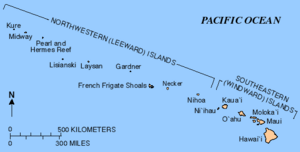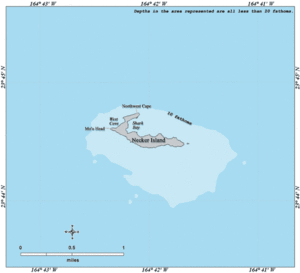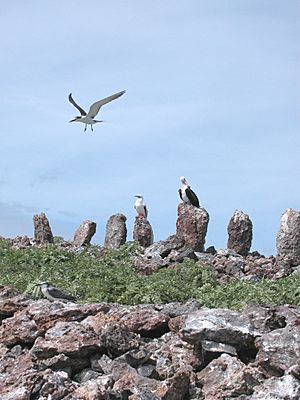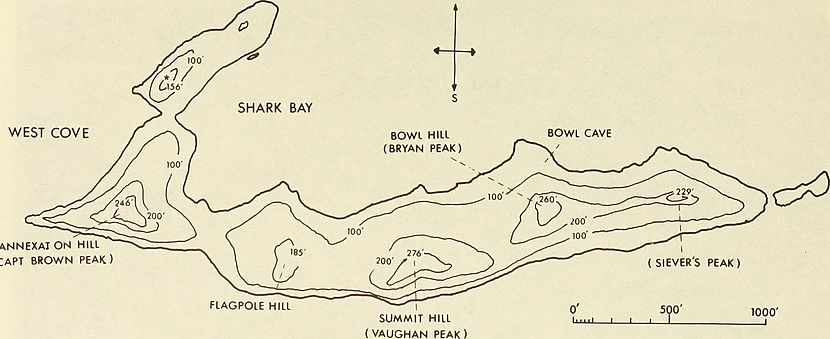Necker Island (Hawaii) facts for kids
Quick facts for kids |
|
|
Necker Island Archeological District
|
|
 |
|
| Nearest city | Pu'uwai, Ni'ihau, Kaua'i County Hawaii |
|---|---|
| Area | 45.193 acres (182,890 m2) |
| NRHP reference No. | 88000641 |
| Added to NRHP | June 13, 1988 |
Necker Island, also known by its Hawaiian name Mokumanamana, is a small island in the Northwestern Hawaiian Islands. It is located far out in the Pacific Ocean, about 155 miles (250 km) northwest of another island called Nihoa. It is also about 8 miles (13 km) north of the Tropic of Cancer.
This island is very important because it has ancient archaeological sites from the Hawaiian culture. It is part of the Hawaiian Islands National Wildlife Refuge. This refuge is a protected area for wildlife.
The island is quite rocky and has steep sides. It does not have much soil. Its highest point is about 277 feet (84 meters) high. Necker Island was named after Jacques Necker. He was a finance minister for King Louis XVI of France.
Contents
What is Necker Island Like?
Necker Island is a long, narrow rocky ridge. It is about 0.7 miles (1.1 km) long and only about 330 feet (100 meters) wide. The island has a hook shape on its west end. This hook forms a small bay called Shark Bay on the north side. The total area of the island is about 45 acres (18 hectares).
The westernmost part of the island is called Mo'o Point. The northernmost point is known as Northwest Cape. Between these two points is West Cove.
The island's ridge has five peaks along it:
- Siever's Peak (61 meters high) – This is the easternmost peak.
- Bowl Hill (79 meters high)
- Summit Hill (84 meters high)
- Flagpole Hill (56.4 meters high)
- Annexation Peak (75 meters high)
The island has some low shrubs and grasses growing on it. It is also famous for having a very large number of birds.
Plants and Animals of Necker Island
Five types of plants are known to grow on Necker Island:
- Goosefoot shrub (Chenopodium sandwicheum)
- Bunch grass (Panicum torridum), also called kakonakona
- Purslane (Portulaca lutea), also called ihi weed
- Pickle weed (Sesuvium portulacastrum)
- Ohai shrub (Sesbania tomentasa)
Many seabirds live and nest on Necker Island. The Blue-Grey Noddy seabird was first found here in 1903. Scientists believe that about 16 different kinds of seabirds nest on the island. Their populations can reach tens of thousands of birds.
The ocean around Necker Island has been studied for its fish. Deep-sea fish live hundreds of meters under the water around the Necker seamount. These include types of fish like Stomiiformes, Gadiformes, Myctophiformes, and Aulopiformes.
Ancient Settlements and History
Necker Island has many stone structures. These are thought to be ancient ritual shrines. There are not many signs that people lived on the island for a long time. This makes experts think that people only visited the island for short periods. Many anthropologists believe the island was a special place for ceremonies and religious practices.
According to old stories from the people of Kauai, Necker Island was the last home for a mythical race of "little people" called the Menehune. The legend says the Menehune moved to Necker Island after being chased from Kaua'i by stronger Polynesians. They then built the stone structures there.
People are thought to have started visiting Necker Island a few hundred years after the main Hawaiian Islands were settled. These visits stopped a few hundred years before Europeans arrived.
Who Discovered Necker Island?
The French explorer Jean-François de La Pérouse was the first European to visit the island. He arrived in 1786. His ships were called L'Astrolabe and La Boussole. La Pérouse was on a mission from the French Academy of Sciences. His team made many discoveries across the Pacific Ocean. They had also just found the French Frigate Shoals. The expedition was lost at sea in 1788, but their logs were sent home.
The old settlements seen by early explorers on Nihoa and Necker islands led them to be called the 'mystery islands'.
Later History of Necker Island
In 1859, Lieutenant J.M. Brook of the survey ship USS Fenimore Cooper mapped the exact location of Necker Island.
In the 1890s, people thought about using Necker Island as a stop for a telegraph cable. This cable would connect Canada and Australia.
In 1902, the ship Albatross from the U.S. Fish Commission visited Necker Island. They discovered the Blue-grey noddy bird there. This bird was first called the Necker Island tern.
The United States Revenue Cutter Service visited the island in 1910 and 1913. They used the ship USRC Thetis.
The warden of the Hawaiian Islands Bird Reservation visited the island in 1919. He also found a piece of a stone artifact.
The Tanager Expedition visited the island in the early 1920s. This expedition is known for studying the island's plants, animals, and ancient sites.
Because of its use by Native Hawaiians as a ceremonial and religious site, Necker Island was added to the National Register of Historic Places in 1988. This means it is a very important historical place.
Mysterious Artifacts
Many interesting artifacts have been found on Necker Island. Among the most mysterious are about a dozen carved stone sculptures. These sculptures look like small, neckless people. They are not more than 1.5 feet (0.46 meters) long. Their style does not match the art of Hawaii or other Polynesian idols.
Other artifacts found on the island include carved stone bowls and various tools.
Images for kids
Map
See also
 In Spanish: Isla Necker para niños
In Spanish: Isla Necker para niños









